Why are the world’s best loudspeakers so expensive?
 Bowers & Wilkins
Bowers & WilkinsThe world’s flashiest loudspeakers are a mix of extreme engineering and unreal aesthetics. But can the astronomical price tags be justified?
“If I ventured in the slipstream,” sings Van Morrison, heartily. “Between the viaducts of your dream…” The lyrics from his 1968 masterpiece Astral Weeks pour out across the room via a pair of £14,000 ($21,500) speakers. They’re turned up pretty loud. Detail locked in the recording comes bursting through.
In particular, the stereo imaging (a kind of acoustic illusion) is super sharp, with instruments crisply defined and clearly discernible as coming from different sides of the “stage”. Violins and flutes ripple off to the left, the bass hangs low and a little to the right, while Morrison himself, beating the rhythm into his guitar, booms directly from the centre.
Bowers & Wilkins, the company that makes these Diamond 802 speakers, has a range of even more expensive offerings – such as the eccentrically seashell-shaped “Nautilus” model, which retails at £60,000 ($92,100).
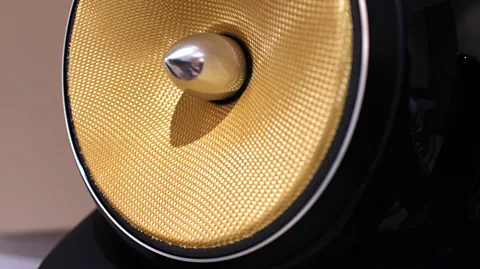 Chris Baraniuk
Chris BaraniukA range of companies now produce eye-wateringly priced loudspeakers like these. Take the £130,000 ($200,000) Magico M Project units, for instance – or the space age-style Transmission Audio Ultimate system that sells for over £1m ($1.5m).
Are such units really worth the money? To find out more, BBC Future decided to take a closer look at the engineering decisions that go into making one of these high-end loudspeaker designs, as well as the exotic ways they are tested – using everything from lasers to strange, noise-free chambers.
You could be forgiven for thinking that most of the effort goes into designing the inverted cone “diaphragms” on the front of a speaker. Yet to make a speaker like the Diamond 802 at Bowers & Wilkins, as much effort goes into the casing. “The single biggest cost with this speaker is probably the cabinet,” explains Danny Haikin, the company’s brand director. The curved outer body of the Diamond 802 boasts 20 layers of beech and multiple coats of lacquer, and it takes days of polishing. This Bowers & Wilkins video below demonstrates the process:

That curved, layered beech is particularly strong – which is important for sound delivery. “Really you don’t want to hear the cabinet so the point about making it stiff is that it has no resonance, it doesn’t act as its own drive unit,” he says. When the diaphragm vibrates, the back-and-forth motion creates sound waves in front of it – but also behind it. So if the casing vibrated significantly too, it would add additional sound to the mix, causing the music to be out of sync.
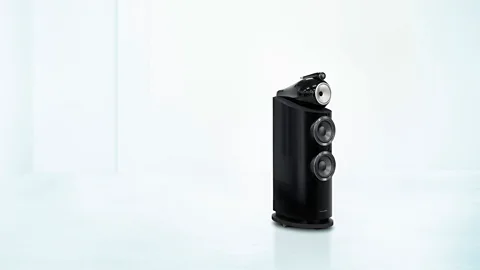 Bowers & Wilkins
Bowers & WilkinsThat’s also why some of the Bowers & Wilkins speakers have a kind of inverted “horn” behind some of the drive units – very visible protrusions shooting out from the rear of each cone on the Nautilus for example. These dampen and channel unwanted sound away from the listener.
There’s more, though. The company has even developed synthetic diamond domes – about a couple of inches across – for the “tweeters”. These are drive units which deliver the upper frequencies (higher pitch) parts of an audio signal. Anyone making a speaker wants the diaphragm or dome to be as stiff as possible – but also super light. This is so that when it moves back and forward it can push air around with very little energy expended and without warping under the pressure exerted on it in the process. Diamond, which is very hard and very light, is therefore a good choice.
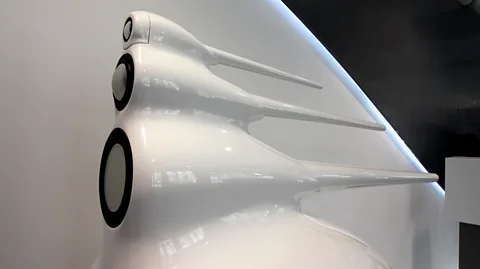 Bowers & Wilkins
Bowers & Wilkins“That is grown in a massive great 1,500C oven which replicates volcanic conditions,” says Haikin as he points out that the diamond component alone costs around £1,000. That’s why speakers that have it are much more expensive than those that don’t.
The list of engineering features goes on. From larger diaphragms made with what is described as “an aerospace material” to surfaces carefully dimpled – like golf balls – so that air passes over them more smoothly. The result in this case is less unwanted noise from the bass, apparently, even at louder volumes.
Looking the part
As you might expect, a lot of thought goes into the appearance too. Haikin points out that the market for speakers like this is overwhelmingly male. They’re therefore designed to be reminiscent of other sleek and curvy products which have traditionally been marketed more towards men – such as sports cars.
Superficial? Perhaps not. According to Rob Oldfield, an acoustics expert from the University of Salford, tests have shown that people genuinely believe a speaker sounds better the more aesthetically attractive they think it is.
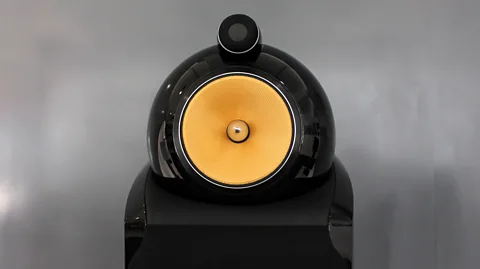 Chris Baraniuk
Chris Baraniuk“That whole perception of ‘this feels like a quality product, it feels like something really nice’, will change how you then consume the audio,” he explains. Much like how colour and texture impact the perception of a particular flavour, so too may our ears be massaged not just by what we hear – but also what we see.
Lab tests
Oldfield’s acoustic lab is frequently used as a testing arena for high-end speaker systems. That includes everything from using a microphone to “listen” to speaker frequencies, to lasers which optically monitor the movement of a speaker diaphragm and detect when they distort – even slightly – interfering with the audio.
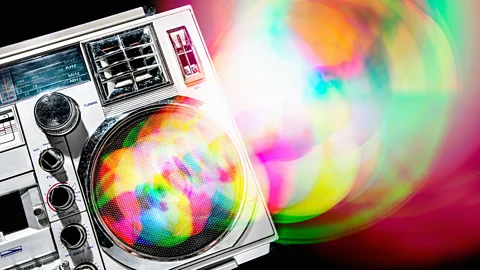 Getty Images
Getty ImagesOne of the key facilities, though, is an anechoic chamber. In this room, the walls, ceiling and floor (below wire netting on which people may stand) are all covered in thick foam wedges. Sound waves disappear into the crevices between these wedges and are very effectively absorbed – hence the name “anechoic” (anti-echo).
Why is this useful for speaker testing? The answer comes in the form of the room’s “speaker robot” – actually more of a mechanical gimbal – to which a speaker can be attached and then moved around at different angles. By pointing it at a microphone in this room and then gradually turning the speaker so that it eventually faces away, researchers can get an idea of how good it is at projecting sound outwards in an arc – listeners aren’t always able to sit right in front of speakers so balanced directionality is important.
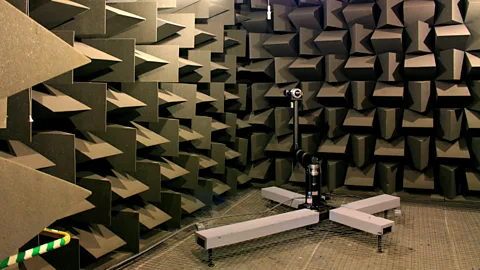 Chris Baraniuk
Chris BaraniukIn order to demonstrate why this is tricky, Oldfield speaks a few sentences while turning round slowly 360 degrees. When he faces away his voice becomes significantly quieter – thanks to a lack of echo – but also, interestingly, it sounds duller too. This illustrates the fact that higher frequencies are more directional than lower ones and can only properly be heard when the source of them is facing you. Speakers have to be designed to compensate for this by projecting high frequencies as clearly and widely as possible.
“There are two elements that people generally try to look at,” says Oldfield. “One is making low frequencies more directional and the other is making high frequencies less directional. You don’t want loads of energy in the low frequencies coming from behind but at the same time you want your high frequencies to be as wide as possible so no matter where you are in the room you get the same sort of experience.”
 Chris Baraniuk
Chris Baraniuk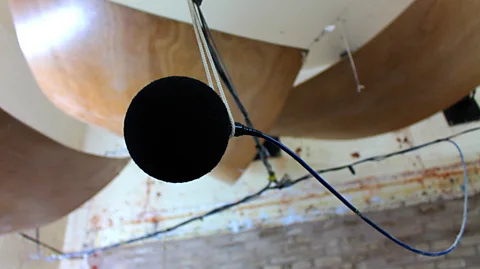 Chris Baraniuk
Chris BaraniukAnother useful room at Salford for checking out the worthiness of expensive speakers is the listening room. It’s specially designed so that speakers sound their best to human subjects. There are foam absorbers on the walls to dampen the sound a little, though not a mass of wedges as in the anechoic chamber. And, indeed, there are cleverly crafted uneven hard surfaces which act as “diffusers”. The idea here is to reflect sound off a varied plain rather than a uniform one. This has the effect of removing coloration and echoes without soaking up and quietening the sound itself.
Both Oldfield and Haikin acknowledge that actually listening to speakers is hugely important, and a key part of the design process, because technical measurements can tell you relatively little about how a speaker actually sounds to human ears.
 Thinkstock
Thinkstock“If you showed me a whole load of frequency responses I wouldn’t be able to say that’s your £20,000 one and that’s your £500 one,” comments Oldfield. “It’s more complicated than that and the perceptual aspect is very important.”
Meaning, essentially, that it’s a largely subjective response. Haikin meanwhile makes another crucial point. Speakers are trying to achieve the impossible.
“A loudspeaker is a fundamentally compromised device,” he says. “You’re trying to reproduce a 40-piece orchestra from five- and eight-inch discs moving in two dimensions in a completely different environment to the environment the music was recorded in in the first place.”
 Thinkstock
ThinkstockSo, is a loudspeaker costing tens or hundreds of thousands worth all that money, then? Perhaps that’s a question only the people who have heard them can answer.
Not everyone from those ranks, however, is convinced. Rob Oldfield says he’s become quite used to listening to music on tinny Bluetooth speakers and via his tablet these days. “I don’t see why you’d want to spend this much money on a loudspeaker,” he says with a shrug. “But,” he adds knowingly, “I’m not representative of the whole audio world.”
